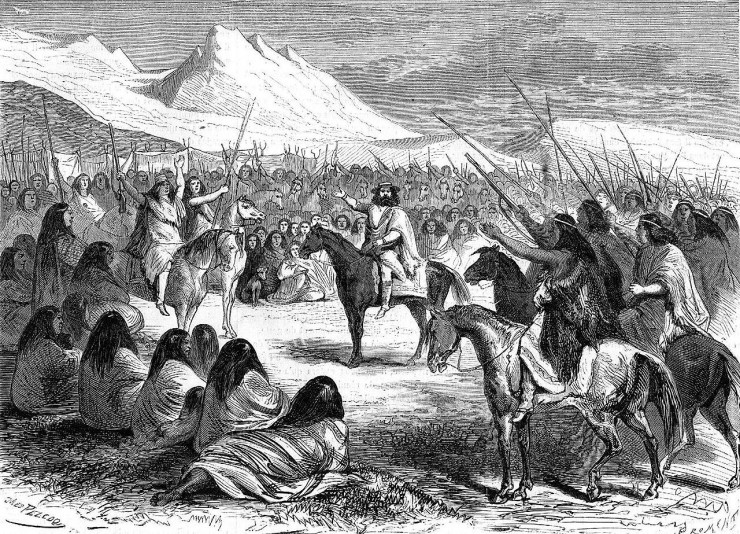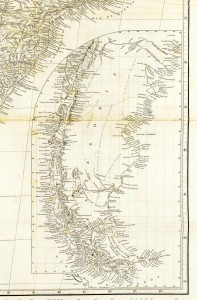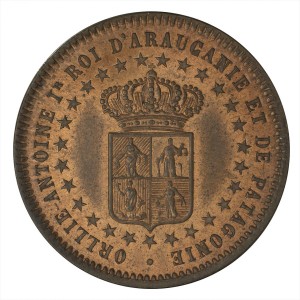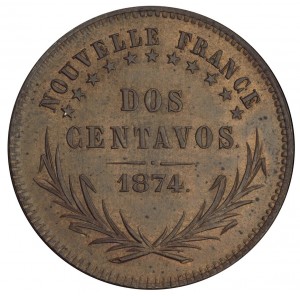Coins from a nation that wasn’t: Araucania and Patagonia
By David Bergeron, Curator
D’Antoine de Tounens in a meeting with the Mapuche people of Patagonia. (Wikimedia Commons, Jules Peco?)
It is not unusual for “micro-nations”— city-states, principalities or minor kingdoms—to produce their own currency. Having a national currency is one way that a fledgling nation can promote its independence—sometimes before there even is a nation. But this coin, from a purely conceptual country in South America, is most intriguing for the history it now represents: the attempt of an indigenous people to establish their own nation in the face of colonization. Even more intriguing, what’s stamped on the coin implies this imaginary nation had already been colonized–by France.
Patagonia from the survey by the British ships Adventure and Beagle. (Wikimedia Commons, John Arrowsmith, 1842)
In the middle of the 19th century, a French lawyer and adventurer named d’Antoine de Tounens became fascinated by the Mapuche people of the Patagonia region of South America. The Mapuche were struggling to protect their ancestral lands, their identity and their culture from colonial expansion by the governments of Chile and Argentina. De Tounens went to Chile in 1858 to meet the Mapuche, whom he admired for what he regarded as their heroic resistance, and took up their campaign for self‑determination and sovereignty. In co-operation with their leaders, de Tounens drafted a constitution for “Araucania and Patagonia”, a region located in the southern half of modern Chile and Argentina. They declared the district a kingdom and de Tounens was named as its first monarch. The Chilean government arrested him in 1862, put him on trial and declared him insane. Narrowly avoiding execution, de Tounens was deported to France.
The National Currency Collection possesses three 2-centavo coins minted for Araucania and Patagonia in 1874. What is so curious about these coins is that they claim this potential nation for France. The legend on the reverse reads “NOUVELLE FRANCE / DOS / CENTAVOS / 1874". De Tounens appeared to have baptized the nation as part of New France, yet this designation is seen nowhere else but on the coins. The coins don’t originate from South America but by some accounts may have been struck, presumably at de Tounens’ request, in Belgium.
De Tounens intended to take the coins back with him to Patagonia to help re-establish his kingdom. Although he returned and failed on several occasions, a number of countries did choose to recognize his fledgling state. But it was not to be. In 1878, Orélie-Antoine de Tounens (as his magisterial name was) died in France as the exiled King of Araucania and Patagonia. A successor to the office of Royal Highness to the Crown of Araucania and Patagonia (in exile) still lives in France today–Prince Antoine IV.
The Museum Blog
New Acquisitions
By: Paul S. Berry
In May 2013, staff of the Bank of Canada Museum visited BABN and were able to select for the National Currency Collection more than 650 steel dies (small, engraved metal or “intaglio” plates) and other production tools formerly used by the company to prepare the intaglio printing plates.
A bank NOTE-able Woman II
By: Graham Iddon
On 15 April, the public consultation to select an iconic Canadian woman to appear on a bank note closed. Over 26,000 nominations were received following the Bank of Canada’s open call—a great success.
New Acquisitions
By: Paul S. Berry
Canadians, on occasion, have used money as a signboard for political protest, a platform for social commentary and even as a handy notepad on which to record fleeting thoughts before they are lost.
A bankNOTEable Woman
By: Graham Iddon
Representing significant women on national currency is gaining momentum all over the world. At least 12 countries currently feature historically notable women on their money…
Museum Reconstruction - Part 4
By: Graham Iddon
It seems a pretty strange building but now it has a solid roof, glass walls and doors. Doors? Ah, there’s your clue. It’s no skateboard park—it’s the entrance portico for the Bank of Canada Museum.
Decoding E-Money II
By: Graham Iddon
This has been an extremely challenging exhibition to develop. We are taking, for us, the unprecedented step of interpreting something that is not only current but continually changing.
New Acquisitions
By: David Bergeron
In late April of 2015, the National Currency Collection finally succeeded in acquiring a Spanish gold cob—famous in legends and tales of pirates and their buried treasures!









